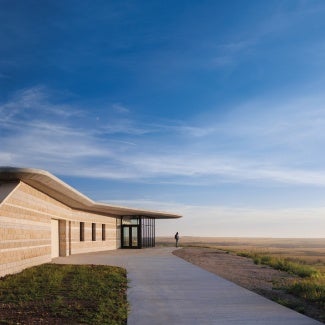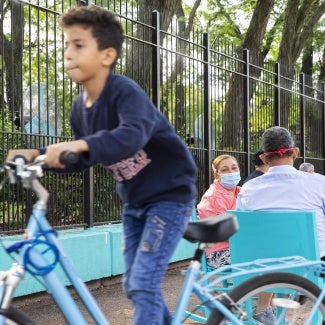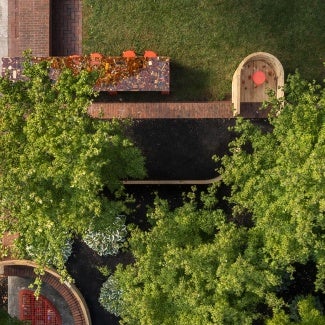West Campus Residence
The award-winning small project design of West Campus Residence in Austin, Texas, creates a compact and efficient family space that is tuned to its natural surroundings.

Project highlights: West Campus Residence
- Architecture firm: Alterstudio
- Location: Austin, Texas
- Category: Three
- Project site: Residential - single-family detached
- Building program type(s): Previously developed
After leaving a cherished modernist residence they called home for more than a decade, the architects and owners of this project purchased a student rental that sat on an unusual 80-foot-wide lot. The design for the home, which accommodates a growing family that includes a set of twins, is guided by a desire for a compact and efficient space that is tuned to its natural surroundings.
Austin’s West Campus neighborhood plan offers a mix of housing types, carefully balancing single-family residences with high-rise multifamily buildings closer to the University of Texas’ campus. The architects’ deep knowledge and commitment to the neighborhood helped as they purchased the rental worked with neighbors in obtaining a variance to subdivide the property into two thin lots. While modest in terms of density increase, the subdivision brings new families to this quickly transforming neighborhood.
Throughout, the home underscores that compact living is an exercise in distilling spatial concepts to create an ensemble both efficient and generous. Its first floor is neither a warren of undersized spaces nor a contiguous great room. Instead, a series of spaces are both linked and differentiated by their architectural elements. Glazing that wraps the first floor disappears into the surrounding construction, seamlessly connecting interior and exterior spaces. Above, a larger second floor that allows each child to have their own room creates a series of porches that engage with the street at the front of the home and offer privacy at its rear.
The lower level takes advantage of its position beneath the tree canopy, its tempered daylit environment an important respite from the ever-present Texas sun. It is darker and more tactile than the second floor, with soapstone counters, mill-finished steel paneling, and white oak throughout. The second floor, by contrast, is the lower level’s bright counterpoint. Its bedroom windows project beyond the floor and ceiling, giving its occupants a sense of spilling out into the surroundings. There, smooth-finish drywall prevails, while oak flooring and limited steel create a link to the spaces below.
Overall, this home eschews housing trends dominating nearby Austin neighborhoods and prevailing real estate guidance. At just 1,922 square feet, it easily accommodates a family of five through a series of inventive solutions that support spatial efficiency and generosity.
Framework for Design Excellence measures
Was there a design charrette? Yes
Level of community engagement:
Not applicable
Site area that supported vegetation (landscape or green roof) pre-development: 82%
Site area that supports vegetation post-development: 75%
Site area covered by native plants supporting native or migratory species and pollinators: 75%
Strategies used to promote Design for Ecosystems: Biodiversity, Dark skies, Bird safety, Soil conservation, Habitat conservation, flora/fauna
Is potable water used for irrigation? Yes
Is potable water used for cooling? No
Is grey/blackwater reused on-site? No
Is rainwater collected on-site? No
Stormwater managed on-site: 100%
2030 Commitment baseline EUI: 32 kBtu/sf/yr
Predicted net EUI including on-site renewables: 19.2 kBtu/sf/yr
Reduction from the benchmark: 40%
Is the project all-electric? No
Level of air filters installed: MERV 15-16
Was a “chemicals of concern” list used to inform material selection? Yes
Do greater than 90% of occupied spaces have a direct view to the outdoors? Yes
Were embodied carbon emissions estimated for this project? Yes
Estimated service life: 100 years
Floor area, if any, representing adapting existing buildings: Not applicable
Ability to survive without utility power: Passive survivability
Risk assessment and resilience services provided: Not applicable
Has a post-occupancy evaluation been conducted? Yes
Building performance transparency steps taken:
Present the design, outcomes, and/or lessons learned to the office.
Project team & jury
Year of substantial project completion: 2019
Gross conditioned floor area: 1922 sq. ft.
Architect: Alterstudio
Architecture Engineer - Structural: Duffy Engineering, Inc.
Engineer - MEP: Positive Energy
Engineer - Geotechnical: Capital Geotechnical Services
Engineer - Civil: Prossner and Associates, Inc.
General Contractor: Green Places
Chandra Robinson, AIA (Chair), LEVER Architecture, Portland, Ore.
Katherine Hogan, AIA, Katherine Hogan Architects, Raleigh, N.C.
Chris Baribeau, AIA, Modus Studio, Fayetteville, Ark.
David Corban, AIA, David Corban Architects, Naples, Fla.
Madhubala Ayyamperumal, Assoc. AIA, Gensler, San Francisco
AIA and its Small Project Design (SPD) Knowledge Community present the annual Small Project Award Program to raise public awareness of the value and design excellence that architects provide regardless of the limits of size and budget.
Nine projects showcase the best small project design and the big impact small projects can have on people and communities.













